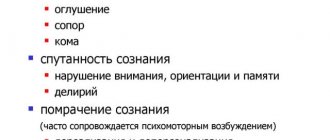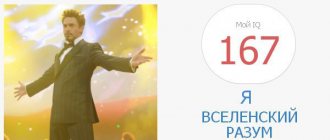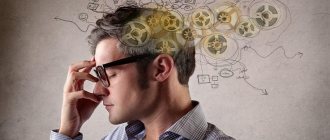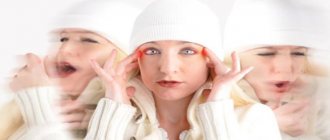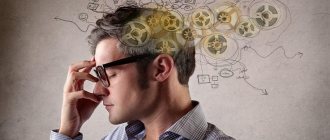Impaired consciousness is a human condition in which signs such as a disorder in the perception of objects, a violation of rational cognition, disorientation and difficulty remembering current events appear. All these signs will be discussed in more detail below.
- Signs of impaired consciousness
- Diagnostics
- Types of non-productive impairment of consciousness Stunning
- Nullification
- Somnolence
- Stun
- Sopor
- Coma
- Delirium
Signs of impaired consciousness
The first of the signs was named above. This is detachment; a person’s perception of the objects around him is “switched off” or it is very difficult. The surrounding world can be perceived as separate fragments or distorted, which is called a perceptual deception.
The next sign is a violation of rational cognition. A person does not understand what connection exists between objects, due to the fact that the ability to judge something is impaired, thinking is disorganized (in some cases it is completely absent).
A person does not orient himself in time, place, and does not understand who surrounds him. Sometimes, when consciousness is impaired, a person does not understand who he is. He may also believe that he is in a completely different place than he actually is. A person does not remember what happens, as well as his feelings at the moment of disturbance of consciousness. This is called congrade amnesia in the medical literature. In some cases, memories are incomplete or their sequence is disrupted. Sometimes memories seem like dreams.
But in some cases, after a disturbance of consciousness, the so-called Moli phenomenon is observed. A person can verbally reproduce everything that happened to him and feels quite active. Retarded amnesia may occur. This is forgetting that occurs at least 3-4 minutes or 2-3 hours after the person has regained consciousness.
Diagnostics
If all 4 of the above signs are present, this indicates darkness or disturbance of consciousness. This condition can affect people of any gender, age and race. Confirmation of the diagnosis does not require confirmation of amnesia or the end of acute psychosis. It is worth noting that consciousness can be only slightly impaired, then the person does not lose the ability to make specific judgments and does not get lost in place.
Sometimes the diagnosis is made retrospectively (that is, after the person has already experienced a violation of consciousness and restored it). Then you need to focus on the amnesia that was noted at that time, and on the remaining memories, which differ depending on the form of confusion. But the type of consciousness disorder is not always clearly defined due to mixed manifestations. Then, when forming a diagnosis, the form is not indicated, just about.
Types of non-productive disorders of consciousness
Disturbances of consciousness can be productive or unproductive. With the latter, the activity of consciousness is reduced and there are no productive psychopathological symptoms, that is, deceptions of perception and delusions. There are three forms:
- stun
- sopor
- coma
Stun
When a person is deafened, the threshold for perception of external factors and internal impressions increases. Mental activity becomes poor, gradually fading away to an increasing extent. When stunned, only a very intense factor can attract a person's attention. A person does not answer questions immediately, and may not understand complex sentences. He usually answers after a long silence and in short phrases.
When a person is stunned, he is poorly oriented where he is and what places are located relative to the point where he is at the moment. There may be no orientation at all. A person is prone to indifference, akinesia, spontaneity and drowsiness. The voice is quiet, there is no modulation in it, there are no gestures, minimal facial expressions. Perseverations are recorded. The person does not remember that he was in a state of stun for some time. There are no fears.
Nullification
This condition is a mild degree of stunning. At the same time, the person seems uncollected or a little drunk. The meaning of speech (if addressed) is understood after some time. The answers may not correspond to the question, and the actions may also seem incorrect. There may be euphoria and fussiness. At times, for some moments, the person returns to normal consciousness.
An example of nullification: a person was injured in an accident, but does not understand this, and begins to actively remove doctors and try to help his loved ones who also suffered in this situation.
Somnolence
This condition is a form of unconsciousness. The person is very sleepy. If you don’t talk to him or make physical contact, he immediately falls soundly asleep. If you shake him and talk to him, he wakes up. But then he falls asleep again. Somnolence is noted upon recovery from an epileptic coma after seizures. After a seizure, you should not try to wake the person. This is not only difficult, but also dangerous, because it can cause an outbreak of aggression in the patient.
Stun
In its manifestations, stunning is similar to psychoorganic syndrome, but these are not synonyms. Main features:
- memory weakness
- impaired judgment
- aspontaneity
- torpidity
Stunning occurs in patients who are emerging from a coma. After stunning, a coma or a state of stupor can be recorded, which will be discussed in detail below.
Causes of stunning:
- swelling and swelling of brain tissue
- lack of oxygen reaching the brain
- acidosis due to intoxication, skull injury, etc.
Sopor
In this state, a person has only minimal signs of mental activity. If you call his name loudly, the person may turn around. If a person feels pain, he groans or tries to avoid the source of pain. Neurological disorders are also characteristic:
- decreased skin reflexes
- minimizing periosteal reflexes
- weakened tendon reflexes
- decreased muscle tone
Conjunctival and pupillary reflexes, as well as sensitivity, remain normal.
Coma
This condition is characterized by complete depression of mental activity. Main features:
- pelvic disorders
- pathological reflexes
- mydriasis with lack of pupillary response to light
- bulbar disorders
- lack of reflexes
- muscle atony
Transcendent coma is brain death, in which the functioning of internal organs is supported with the help of special devices. The condition is also known as supernumerary coma.
Types of impaired consciousness
Impaired consciousness is divided into two groups: productive and unproductive. In the first case, the patient experiences hallucinations, deceptions of perception, imaginary objects and objects, which occurs in the case of mental painful conditions. Non-productive disorders of consciousness are the result of severe somatic illnesses, injuries or infections that affect the nervous system, so they are observed not only in psychiatry.
Non-productive disturbances of consciousness (blackout)
Stun
This condition is characterized by the fact that only intense stimuli cause a reaction in the patient (the threshold for responding to external stimuli increases). The patient understands the informational meaning of stimuli, but at the same time, orientation in time and environment is difficult, combined with psychomotor retardation. In addition, mental activity slows down. Verbal contact with the patient is difficult. The person responds with simple phrases, he is indifferent, drowsy, and takes a long time to react to any stimuli.
Light forms of stunning:
— Nubilization. Patients become fussy and excited. Clarity of consciousness fluctuates; a person can be involved in a situation for a short episode, and then absent again. Also characteristic is the lack of criticism of one’s own condition. This is well illustrated by the example of car accident victims who, in a state of shock, fussily help others, not noticing their own injuries.
— Domnolence is a form in which a person falls into a state of prolonged sleep, from which it is difficult to wake him up. When trying to wake the patient, aggression can be provoked. After a short awakening, instantaneous sleep occurs. Somnolence is observed in patients after recovery from an epileptic coma or a series of seizures.
Sopor
Stupor is a more serious condition than stupor. Consciousness is not completely turned off, but the patient does not understand the meaning of the addressed speech. Only elementary manifestations of mental activity are observed, only the most primitive reactions to stimuli are preserved. For example, when receiving an injection, the patient will make a grimace of pain, but will only respond to loud calls by turning his head. Muscle tone is reduced, reflexes are weak, pupillary reaction to light is slow.
Fainting
Fainting occurs when consciousness completely turns off and the patient does not respond to any stimuli (with ischemia - acute oxygen starvation of the cortex).
Coma
Coma is a serious condition characterized by complete suppression of mental activity. There is a deep degree of disturbance of consciousness - complete shutdown of consciousness and shutdown of reflexes (absence of pupillary and corneal reflexes). The muscles completely lose tone, there are no reflexes. The patient does not respond to external stimuli or any irritants.
Productive disturbances of consciousness or confusion
Delirium
This condition appears during intoxication (alcohol, atropine). Delirium can also be caused by infection (typhoid, influenza) or traumatic brain injury (TBI).
Delirium is characterized by loss of orientation in place and time while maintaining it in relation to oneself. Accompanied by bright, lively and moving visual hallucinations (less often auditory). Patients are full of fear, anxiety, fussy, restless.
The appearance of perceptual disturbances is characteristic. The patient experiences hallucinations and may also have illusions.
Hallucinations during delirium are most often visual and tactile, less often auditory. Often the patient sees animals (rats, small animals - zoohallucinations), demons, excessively large or small objects (more often - microhallucinations). Tactile hallucinations are also observed (for example, the presence of small creatures under the skin); the patient sees networks, cobwebs, and wires. A striking example is the thread symptom. A patient with delirium tremens may see an imaginary thread between the doctor's fingers. Different intoxications have their own specific symptoms. Thus, with cocaine delirium, Magnan’s symptom is observed, when the patient experiences tactile hallucinations in the form of the presence/sensation of small foreign bodies or insects under the skin, as well as crystals.
Sometimes images take on a scene-like character, like a movie.
In addition to distorted perception, thinking and memorization are impaired. A person expresses unstable delusional ideas and sees false images of people. After recovery from delirium, fragmentary, torn memories of past events are observed.
The orientation is specific. The patient is aware of his identity, but is lost in place and time. If we talk about emotional changes, then there is affective instability. Fear, overwhelming horror, surprise or sudden aggression, tearfulness dramatically change each other. Sometimes the patient displays a humorous attitude towards current events (“gallows laughter”). The behavior of a person suffering from delirium is also severely disturbed. He is fussy, restless, defending himself from something, running somewhere. There is motor agitation and the patient is difficult to control.
The intensity of delirious disorders increases in the evening and at night, and decreases during the day.
Oneiroid
Delusional, fantastic disturbance of consciousness, similar to a long dream.
Oneiroid is a condition that patients describe as a dream. This is an involuntary influx of pictures of fantastically delusional content, which have a completed plot and replace one another. The patient acts as a spectator. Dual orientation may occur when a person is in two places at the same time. This applies not only to place, but also to time.
Symptoms of oneiroid are polymorphic (varied). The patient can see himself in oneiric scenes, feels an involuntary flow of vivid thoughts and images. The experiences are scene-like in nature. It is noteworthy that the images and psychopathological disorders are within the same plot, that is, they are systematized and have a unique plot, in contrast to delirium.
Personal orientation is sharply disrupted. The patient is not aware of himself, he becomes a participant in events and influences the picture of the fictional world, which does not happen with delirium, where the person plays the role of an observer.
In the literature, two variants of oneiroid are distinguished: depressive (scenes of hell, torment, cataclysms are observed) and expansive (visions take on the character of long journeys, space flights, magical scenes). The patient feels himself in a different world, which may have different affective overtones depending on the oneiroid variants described above. Much more often in practice, expansive oneiroid is observed, in which ecstatic affect is typical, when the patient experiences a feeling of delight and happiness. After emerging from this state, patients sometimes want to return back to oneiric sensations.
Twilight stupefaction
This is a special condition that has an abrupt onset and sudden end. The name of this disorder is due to the fact that when it occurs, the circle of motives, ideas and thoughts narrows, which is reminiscent of a violation of seeing objects in the dark.
Elementary actions are observed, but the integrity of perception suffers. Consistent thinking and normal activities are not possible. Behavior is not determined by all external stimuli, but only by individually captured stimuli. The perception of objective reality is fragmentary, and the responses are distorted. Disorientation is further aggravated by the fact that selective phenomena are mixed with hallucinatory and even fantastic images. The patient’s external movements are often ordered, but not conscious; the patient’s actions are not predictable and therefore especially dangerous. Often during a twilight episode, people act extremely agitated and may do dangerous, antisocial things, become destructive, and self-harm. The personality is disoriented, and after emerging from twilight, complete or fragmentary amnesia is observed with a critical attitude, less often - the persistence of pathological experiences in consciousness for some time with delusional interpretation (residual delirium).
The twilight state is more often observed with epilepsy, sometimes with pathological intoxication and hysteria.
Amentia
Amentia is a disorder of consciousness in which the patient is extremely confused, disoriented in place, time, and self. Thinking is inconsistent, without logical connection, and movements are chaotic. Speech contact is virtually impossible; speech is devoid of grammatical structure. He resembles a person who is frightened, agitated in bed, cannot feed himself, and spits out food when feeding. At the same time, the emotional state is extremely labile, i.e. in a person, sadness turns into joy, passivity into aggression. Hallucinations are fragmentary, they quickly replace each other. The patient may fall into stupor or motor agitation.
Amentia is observed with head injury, severe intoxication, infectious lesions or schizophrenia.
Productive disorders
Non-productive disorders are discussed above. And the productive ones include:
- amentia
- twilight stupefaction
- oneiroid
- delirium
Delirium
The main signs (symptoms) of this type of consciousness disorder:
- Perceptual disturbances of various forms:
- sensory synthesis disorders
- hallucinations
- illusions
- tactile illusions of perception
- impairment of remembering what is happening, etc.
As for illusions, patients with delirium mainly experience visual illusions. There may also be hallucinations of the following kind:
- cobweb or threads
- wires
- macro- and micropsychic
- polyopic
- cinematic
- palingnostically
- demonomaniacal
- zoological
- scene-like
With delirium, the patient's thinking is characterized by fragmentation, and false recognitions may occur. The patient remembers this period poorly after regaining consciousness. The orientation on the spot is constantly changing and does not correspond to reality. The same applies to orientation in the current situation, the people around you and time. But a person is almost always aware of who he is.
Another feature of delirium is affective lability. A person can quickly change from curiosity to fear to indignation and vice versa. Mostly emotions are negative. A person in this state has a great desire to move, do and say something. A person can defend himself from his hallucinations, attack imaginary and real people, run away, etc. During the day, the symptoms of delirium appear less.
Oneiroid
This is a clouding of consciousness, which is characterized by fantasies, delusions and dreams. Basically, polymorphic psychopathological symptoms are observed. The person experiences pseudohallucinations and scene-like hallucinations. In most cases, catatonic disorders and affective disorders are observed. Fantastic delusional ideas are typical.
A person’s experiences are subject to one direction, one theme. Painful experiences have a romantic-fantasy theme. When a person regains consciousness, he tells doctors and loved ones that he was on other planets, traveled through time, etc. Many people like what they saw so much that they regret that they returned to a normal, healthy state.
For oneiroids, disturbances in orientation in one’s personality are typical. A person considers himself to be another creature, often not a human. That is, the patient himself takes part in his fantasies as an active person, and not as an outside observer. The somatopsychic sphere is involved. A person may believe that his body has become gaseous or consisting of some fantastic matter. The patient is not oriented completely or to a greater extent in the surrounding world. When the peak of the state in question comes, the person is completely detached from what is happening around him. He completely lives the moment in an imaginary world, where he does not see or feel anything that surrounds him in reality.
It is almost impossible or completely impossible to contact a person in a oneiroid state. It is impossible to understand his hallucinations and illusions by the way a person behaves. When the patient returns to consciousness, he does not remember how he behaved, what happened around him, but he remembers his illusions well.
Oneiric clouding of consciousness is observed during attacks of schizophrenia of the fur-like or periodic type, during intoxication psychoses, exogenous-organic and epileptic psychoses. Oneiroid in many cases occurs before delirium, therefore it is very difficult to distinguish between these two states in psychosis.
Twilight stupefaction
The beginning of the condition is always abrupt, as is the ending. The circle of thoughts and motives narrows significantly. A person comes into a state of extreme excitement, and therefore can pose a threat to others. The behavior may appear planned. The person completely loses orientation, and then he has no memories of what was done. Sometimes a person can orient himself a little in his surroundings and recognize some of the people who surround him.
Kinds:
- delusional
- hallucinatory
- dysphoric
- ambulatory automatism
In the delusional variant, the symptoms correspond to the name of the species. Amnesia is often incomplete. In the hallucinatory form, hallucinations can be visual or auditory. With the dysphoric form of twilight clouding of consciousness, fear, rage, and anger are observed mainly, and at the same time consciousness is not clouded to a large extent. With outpatient automatism, there are no attacks of aggression, no hallucinations or delusions. The patient repeats certain movements, mainly walking back and forth. The cause is often alcohol consumption.
Twilight states can be psychogenic. Then the person “emerges” from reality, transporting himself to a situation that compensates for the currently traumatic experiences. The perception of the situation around is incomplete. Speech and actions can be characterized by demonstrativeness. Memory loss can be partial, and it concerns what happened in real life.
Causes of twilight disturbance of consciousness:
- intoxication psychosis
- vascular psychosis
- TBI
- morbid intoxication
- brain tumors
- epilepsy
Prolonged absence seizure
This is a condition that is similar in appearance to stunning. Main features:
- perseveration
- difficulty comprehending impressions
- problems with perception of reality
- minimal mobility
- apathetic state
- adynamia
- wrong actions in some cases
- sudden start and end
- duration up to 3-4 days
- short periods of normalization of consciousness are typical
Amentia
A person falls into absent-mindedness with symptoms of hypermetamorphosis and bewilderment. The emotions he displays change at a rapid pace. Speech is incoherent, the patient talks a lot. Thinking is incoherent. The condition is also characterized by motor agitation, but rarely leaves the bed in which the patient is located. Often throwing occurs without any coordination.
A person does not understand who he is, what is around him. Next comes complete congrade amnesia. Delirious episodes, depressive affects (or manic), and delusional ideas are typical. When consciousness normalizes, asthenic phenomena are observed. A person can remain in this state for 2-3 weeks or even 3-4 months.
Variants of clouding of consciousness during amentia:
- paranoid
- depressive
- manic
- catatonic
- classical
Disorders of consciousness
When consciousness is impaired, the processes of perception, thinking, memory and orientation suffer. The perception of the environment, time and one’s own personality becomes fragmented, “blurred” or completely impossible. Initially, with disorders of consciousness, orientation in time is disturbed. The last to be lost and the first to be restored is orientation in one’s own personality. The degree of disorientation can vary significantly depending on the type of disorder of consciousness - from mild difficulties when trying to communicate the time and date to the inability to determine at least some landmarks.
The ability to comprehend external events and internal sensations is reduced, lost or distorted. Thinking is absent or becomes incoherent. A patient with a disorder of consciousness partially or completely loses the ability to fix his attention on certain objects and phenomena, to remember and subsequently reproduce information relating to both ongoing events and internal experiences. After recovery, complete or partial amnesia is observed.
When determining the type and severity of disorders of consciousness, the presence or absence of all signs is taken into account, however, one or two symptoms may be sufficient to make a diagnosis. The clinical picture of a disorder of consciousness in each specific case is determined by the severity of the underlying pathological process, the localization of the area of damage to brain tissue, the age of the patient and some other factors.
Quantitative disorders of consciousness
Moderate stun
accompanied by a mild disturbance of orientation in time. Orientation in place and self is usually not impaired. Some drowsiness, lethargy, lethargy, deterioration in concentration and comprehension of information are revealed. A patient with a disorder of consciousness follows instructions slowly, belatedly. The ability to communicate productively is preserved, but understanding often occurs only after instructions are repeated.
Deep Stun
– a disorder of consciousness with a violation of orientation in place and time while maintaining orientation in one’s own personality. Severe drowsiness is detected. Contact is difficult, the patient understands only simple phrases and only after several repetitions. Detailed answers are not possible; the patient answers in monosyllables (“yes”, “no”). A patient with this disorder of consciousness can follow simple instructions (turn his head, raise his leg), but reacts late, sometimes after several repetitions of the request. There is a weakening of control over the functions of the pelvic organs.
Sopor
– severe disorder of consciousness with loss of voluntary activity. Productive contact is impossible, the patient does not respond to changes in the environment and to the speech of other people. Reflex activity is preserved. A patient with a disorder of consciousness changes his facial expression and withdraws a limb when exposed to pain. Deep reflexes are depressed, muscle tone is reduced. Control over the functions of the pelvic organs is lost in this disorder of consciousness. Short-term recovery from stupor is possible with intense stimulation (pushes, pinching, painful effects).
Moderate coma
– complete loss of consciousness combined with lack of response to external stimuli. With intense pain, flexion and extension of the limbs or tonic convulsions are possible. Sometimes psychomotor agitation is observed. With this disorder of consciousness, depression of abdominal reflexes, impaired swallowing, positive pathological foot reflexes and reflexes of oral automatism are detected. Control over the functions of the pelvic organs is lost. There are disturbances in the functioning of internal organs (increased heart rate, increased blood pressure, hyperthermia), which do not threaten the patient’s life.
Deep coma
manifests itself with the same symptoms as moderate. A distinctive feature of this disorder of consciousness is the absence of motor reactions in response to painful stimuli. Changes in muscle tone are very variable - from a total decrease to spontaneous tonic spasms. Unevenness of pupillary, corneal, tendon and skin reflexes is revealed. The disorder of consciousness is accompanied by a gross violation of autonomic reactions. There is a decrease in blood pressure, respiratory distress and heart rate.
Terminal coma
manifested by the absence of reflexes, loss of muscle tone and gross disturbances in the functioning of vital organs. The pupils are dilated, the eyeballs are motionless. With this disorder of consciousness, autonomic disorders become even more pronounced. There is a critical decrease in blood pressure, a sharp increase in heart rate, periodic breathing or absence of spontaneous breathing.
Qualitative disorders of consciousness
Delirium
may occur with alcoholism and organic brain damage. Orientation in place and time is disturbed, but in one’s own personality is preserved. Visual hallucinations are observed, other types of hallucinations (auditory, tactile) are less common. Patients with this disorder of consciousness usually “see” real or fantastic creatures, usually frightening, unpleasant, threatening: (snakes, lizards, devils, aliens, etc.). The behavior of patients depends on the content of hallucinations. After recovery, patients retain memories of what happened during the period of disorder of consciousness.
Oneiroid
can develop with catatonic schizophrenia, manic-depressive psychosis, epilepsy, encephalitis, vascular dementia, senile psychosis, head injury, severe somatic diseases, alcoholism and substance abuse. The disorder of consciousness is accompanied by a special disturbance of orientation, in which real events are replaced by hallucinatory and dreamlike experiences. This picture may include real people allegedly operating within the fantasy world generated by the patient's consciousness.
Amentia
detected during intoxication, infectious and traumatic psychoses. Occurs primarily or with worsening delirium, and is a more severe disorder of consciousness. The patient is disoriented in the world around him and in his own personality, constantly, but unsuccessfully, searching for landmarks. Thinking is confused, the synthetic nature of perception is lost. Numerous hallucinations of a fragmentary, fragmentary nature are observed. After recovery, the period of illness is completely amnesic.
Twilight disorders of consciousness
usually occur with epilepsy and are characterized by a sudden disruption of orientation in the environment combined with pronounced affects: anger, melancholy and fear. The disorder of consciousness is accompanied by excitement and sudden influxes of frightening hallucinations in reddish, yellowish or black and blue tones. The patient's behavior with this disorder of consciousness is determined by the content of delusions of persecution or grandeur. The patient shows aggression towards surrounding people and inanimate objects. After recovery, total amnesia develops for the events of the illness period.
Outpatient automatism
- a disorder of consciousness usually observed in epilepsy. It manifests itself as automated actions performed against a background of complete detachment. The patient may spin in one place, lick, smack, chew, or shake something off. Sometimes automatic movements in this disorder of consciousness are more complex, for example, the patient consistently undresses. Fugues (attacks of aimless flight) and trances (long migrations or shorter “falls out of reality”, during which patients pass by their own house, miss a stop, etc.) are possible. Sometimes this type of disorder of consciousness is accompanied by attacks of motor agitation, antisocial or aggressive actions.
Double orientation
– a disorder of consciousness that occurs during delusional states, hallucinations, onirism, oneiroid and dissociative identity disorder. It is characterized by the simultaneous existence of two streams of consciousness - psychotic and adequate. With delusions of grandeur, patients with this disorder of consciousness can consider themselves a great, unusually important person (the savior of people, the emperor of a fantasy universe) and an ordinary person; with delusions of staging, they believe that they are simultaneously in real space and a false zone of staging. “Softer” versions of the disorder of consciousness are possible, in which patients take into account their real qualities, but believe that one “I” is a concentration of advantages, and the other - disadvantages.
Treatment
If a person is in a coma, it is necessary to take preventive measures and eliminate disturbances in vital functions. It is necessary to ensure the supply of oxygen to the patient’s body. They perform artificial ventilation or use other methods. Next, you need to normalize blood circulation in the body. For this purpose, vasopressors or antihypertensive drugs can be used.
If there is a suspicion that impaired consciousness is caused by alcoholic beverages, treatment requires the administration of thiamine in a large dosage. Convulsions in cases of impaired consciousness are eliminated with the help of anticonvulsants. A patient in a coma is given glucose to prevent hypoglycemic brain damage. Next, tests are performed and the dosage is adjusted accordingly.
If the patient is in a state of psychomotor agitation, sedatives may be needed. If the balance of acids and alkalis is not in order, or there are water and electrolyte disturbances, these indicators need to be normalized. Body temperature also needs to be measured and brought back to normal. If the confusion is due to an infection or bacterial disease, antibiotics may be needed. In case of poisoning, detoxification therapy is necessary. After providing first aid, you need to take tests, interview relatives, and do research. The type and degree of impairment of consciousness is determined, and in connection with these data, effective therapy is prescribed.
Chapter 7. Disturbances of consciousness (somnolence, stupor and coma)
Impairments of consciousness are often encountered in medical practice. When assessing them, it is necessary to determine whether there is a change in the level of consciousness (stunning, stupor, coma) and (or) the content of consciousness (confusion, perseveration, hallucinations). Confusion means loss of clarity of thought and inattention: stupor is a condition where strong stimuli must be applied to obtain a response; coma is a state of insensitivity to external stimuli. These conditions are very serious, so it is necessary to find out their causes.
Approach to the patient
1. Maintaining vital functions. 2. Administration of glucose, thiamine, or naloxone (morphine antagonist) if the etiology is unclear. 3. Study of anamnesis, physical, laboratory, x-ray examination to determine the cause of the disease. 4. Adequate drug or surgical treatment.
Anamnesis
The patient should be awakened, if possible, and questioned about the use of insulin, narcotics, anticoagulants, other prescription drugs, suicide attempt, recent trauma, headache, epilepsy, and pre-existing medical conditions. Witnesses and family members must be interviewed, often by telephone. Sudden headache followed by loss of consciousness is suspicious for intracranial hemorrhage; dizziness, nausea, dysyupia, ataxia, unilateral sensitivity disorder - basilar insufficiency; chest pain, tachycardia and weakness - for cardiovascular pathology.
Immediate assessment of the situation
It is necessary to analyze the patient’s condition and carry out appropriate therapeutic measures. The blood is examined for sugar, Na, K, Ca, residual nitrogen, urea, alcohol, ALT activity; toxins. Fever, especially with skin rash, is suspicious for meningitis. Fever against the background of clear skin develops with heat shock or intoxication with anticholinergic drugs. With hypothermia, one should think about myxedema, intoxication, sepsis, radioactive exposure, hypoglycemia. High blood pressure accompanies intracranial hypertension and hypertensive encephalopathy.
Assessment of neurological status
It is necessary to determine the patient’s maximum functionality and symptoms, which will allow a detailed diagnosis to be established. Although impaired consciousness may accompany unilateral brain damage, in general the presence of stupor and coma implies bilateral damage to the cerebral cortex or dysfunction of the midbrain tegmentum (reticular activating system).
The patient's reactions to irritation. Stimulation is carried out with stimuli of varying strengths to assess the degree of reactions, as well as the asymmetry of sensorimotor functions. The patient's motor response can be conscious and reflexive. Spontaneous flexion of the upper limbs at the elbow joints with extension of the lower limbs is caused by decortication and accompanies a serious lesion in the opposite hemisphere above the midbrain. Extension of the elbows, wrists, and lower extremities is caused by decerebrate and suggests involvement of the diencephalon or midbrain. Reflexes associated with body posture may persist in profound encephalopathy.
Pupils. The presence of round, symmetrical pupils that react to light in a comatose patient allows us to exclude damage to the midbrain and assume a metabolic disorder as the cause of the coma. Pinpoint pupils occur in drug overdoses, with the exception of meperidine, which narrows the pupils to medium size. Small-diameter pupils are also observed with hydrocephalus or damage to the thalamus and pons. Damage to the midbrain or compression of the third cranial nerve (with transtentorial herniation) causes unilateral dilatation of the pupil, it becomes oval, and weakly reacts to light. Bilateral dilated pupils with loss of light responsiveness indicate severe bilateral midbrain damage, anticholinergic drug overdose, or ocular trauma.
Movements of the eyeballs. Voluntary and reflex movements of the eyeballs are examined to identify limitations in the range of their movements, involuntary movements and violations of the position of the ocular axes. An abductor resting position combined with an inability to externally rotate the eye indicates abducens (IV) nerve involvement, which is typical of increased intracranial pressure or pontine involvement.
An eye with a dilated pupil that does not respond to light is often retracted outward at rest and cannot be adducted due to dysfunction of the oculomotor nerve (III nerve) with transtentorial herniation. Vertical divergence of the axes of the eyeballs or strabismus occurs when the cerebellum or pons is damaged. The phenomenon of “doll eyes” (oculocephalic reflex) and cold stimulation of the vestibular apparatus (oculovestibular reflex) make it possible to diagnose damage to the cranial nerves in patients who are unable to voluntarily move the eyeballs. The oculocephalic reflex is tested by observing eye movement in response to passive turning of the head to the side (severe neck tissue trauma is a contraindication to this test). Free movement of the patient’s eyes with the phenomenon of “doll eyes” is observed with bilateral damage to the cerebral hemispheres. In a comatose patient with an intact brain stem, raising the head 60° from the horizontal level and introducing ice water into the external auditory canal causes a tonic deviation of gaze towards the irritation. In conscious patients, this test causes nystagmus, dizziness and vomiting.
Breath. Assessing breathing patterns can help determine the level of brain damage. Cheyne-Stokes breathing (periodic) is observed with bilateral damage to the cerebral hemispheres and is typical for metabolic encephalopathies. Breathing patterns that include difficulty breathing and apnea indicate damage to the lower parts of the brain stem; such patients usually require tracheal intubation and assisted ventilation.
Other. The sensorimotor functional activity of a patient in a coma can be assessed by his reflex reaction to stimuli; Minimal reflex asymmetry, which indicates a focal lesion, should be carefully assessed. If possible, a patient with impaired consciousness should have their gait assessed. Ataxia of a patient in stupor can serve as an important diagnostic sign of plus tissue in the cerebellum.
X-ray examination
Pathological factors that increase intracranial pressure usually lead to impaired consciousness. A CT or MRI study of the brain in a patient in a coma often reveals pathological changes, but is not informative in metabolic encephalopathy, meningitis, widespread anoxia or drug overdose, at the initial stage of ischemic stroke, encephalitis. Delaying treatment in these patients while awaiting CT and MRI scans can be dangerous. The condition of patients with impaired consciousness as a result of increased intracranial pressure can quickly deteriorate; in this case, urgent CT is indicated to confirm the presence of plus tissue and justify surgical intervention. CT scan is normal in some patients with subarachnoid hemorrhage, in which case the diagnosis is based on clinical findings of red blood cells in the cerebrospinal fluid (CSF). Cerebral or MR angiography is often necessary to identify basilar artery flow deficiency as a cause of coma in patients with brainstem symptoms.
Brain death
Occurs as a result of complete cessation of brain functions and blood circulation in it while the activity of the cardiovascular system continues (during auxiliary ventilation). An isoelectric line is recorded on the EEG, there is no reaction to external stimuli, and there are no brain stem reflexes. It should be borne in mind that this condition can be provoked by an overdose of drugs and hypothermia. The diagnosis of brain death is made if the situation does not change within a predetermined period (6-24 hours). To confirm apnea, it is necessary to establish that Pco2 is sufficient to stimulate respiration.

